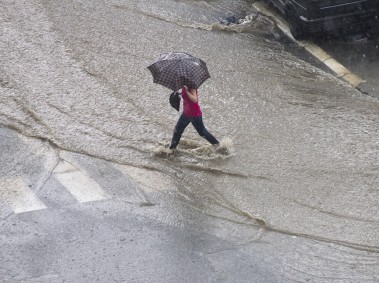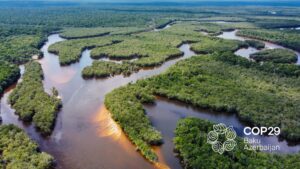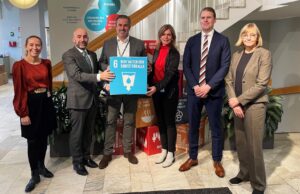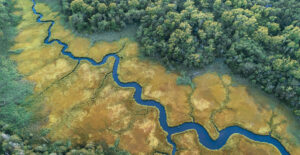Adapting to a Changing Climate: A City, A Country, A Planet
Adaptation to climate change is a key concept in the Climate Agreement set in Paris last year. Many climate change consequences will be water related, such as floods, storms, droughts and reduced water availability or/and quality. We need to plan for these consequences, but there are uncertainties on magnitude, periodicity. How do we plan and adapt under uncertainty?
On 10 March SIWI Swedish Water House hosted a seminar to discuss how planning under uncertainty is addressed at global, national and regional level. John Matthews, Secretariat Coordinator at AGWA, presented new tools for adaptation planning developed by AGWA.[1]
John confirmed that we do not know what the future will look like, and that unfortunately the past is not very informative to project what is happing in the future. To adapt to climate challenges such as climate extremes, super droughts, floods, tropical storms etcetera, climate models are unfortunately not so helpful. AGWA suggest we rather use a bottom up methodology, starting with the concerned stakeholders, make an inventory of successes and failures, identify performance indicators, likelihoods of impacts, robustness of the system etc.
We need “sequential decision making”, a chart where the key decision points are identified, as well as the information and data needed in order to to take the right decisions. This way we achieve stakeholder-driven, uncertainty tolerant, risk assessments and a formal approach to flexible operations and planning. Another way of describing it is to use a “decision tree”, to systematically take the decision making processes at the strategic division of branches, and use robust information and data to choose the right branch.
John stressed that financing is crucial for any adaptation plan, strategy or measure. As green bonds are growing exponentially, AGWA has developed “Water Climate Bond Standards”, to enable green bonds to account for water related risks,
Åsa Sjöström, Head of the Swedish National Knowledge Centre for Climate Change Adaptation, based at SMHI [2] explained that a 2 degree Celsius average global temperature rise means 4-6 degrees Celsius in the northern hemisphere and that we will have severe challenges in climate adaptation also here in Sweden in the future. We can expect more precipitation during winter and spring, and longer and dryer summers. Fires, landslides, heavy rains, flooding and degraded water quality are predicted to increase in amplitude and numbers.
Who is responsible for adaptation to these expected impacts? Nationally Sweden has no appointed national authority. All national authorities have their area of responsibility, within their sector of the government. Regionally the county administration boards are responsible, and locally the councils.
To assist these authorities in adaptation planning, the knowledge center has a web portal with data, facts and information. The Centre is a central meeting point, providing networks and meeting places for government authorities.
Hanna Sundqvist, one of four coordinators of Climate Change Adaptation at the Stockholm County Board was next on stage. She explained that municipalities have the main responsibility for implementation of adaptation. County Boards coordinate activities, review city plans, do contingency work, if a disaster happens.
The scenario for Stockholm is a 3-5 degree Celsius increase in annual temp, precipitation increase with up to 20% with the largest increase during winter and spring. Spring floods may disappear, longer growing season are expected, low flow during the extended summer period. Likely consequences are local flooding due to cloud bursts and higher seas levels, risk for water quality, increased risk for landslides. A key challenge is to protect Lake Mälaren as drinking water source. There are many solutions for adaptation measures, but they are costly, and the question is who is going to fund them, who is responsible?
Anna Forslund, Programme Manager at SIWI moderated the discussion with presenters and the audience on how to deal with uncertainties. Who owns adaption? Who will take responsibility? Who is going to pay? Who decides about a new regulation? Do we need small disasters – maybe they are useful to initiate projects, actions and decision-making?
The issue of responsibility was discussed. The audience reacted on the information that there is no nationally appointed authority responsible for adaptation in Sweden. John Matthews commented that Sweden are where most developed countries are, some positive system thinking is being done, but focus is still on short term issues. Longer term planning and decision making need to be developed.
The need for better data for decision making was also deliberated. On the one hand, one can argue that when data is missing, uncertainty increases. But there is also the risk that lack of data can be used as an excuse for inaction. John argued that new data is primarily needed in developing countries, but we can’t wait, we need to act now on the data and knowledge we have.
Another question is how we deal with uncertainties in Sweden/Stockholm. Do we consider uncertainty at all? The answer is yes and no. Uncertainty intervals are important, but communication is difficult. Scientists prefer to use intervals but intervals cannot be used in planning, so the highest scenario is normally used. It varies also with the projects, if it is a football ground, or a bridge, a new part of the city etcetera.
Private sector, not the least building companies are affected by climate change, and therefor naturally involved in adaptation and planning. The Stockholm County Board have organized a workshop with the building companies on how to manage risk and the benefits of handling risk. Next focus will be insurance companies, forestry sector, and other relevant private sector sectors.
Anna Forslund winded up the discussion with a short reflection on “good adaptation” and how to avoid mal-adaptation? Participation of stakeholders, transparency, use of local traditional knowledge, protection of ecosystems, gender equality” are some defined principles for good adaptation. She asked the presenters to what extent these concepts are considered when planning globally, nationally and regionally for adaptation. According to John, maybe the best philosophy would be to not make things worse. Åsa responded that “due to uncertainty, we have to build flexible solutions”, thereby supporting AGWAs call for systemic thinking. Hanna got the last word and commented that the Stockholm Action plan for climate adaptation is result of stakeholder participation and transparency. She also said that the measures suggested to adapt to climate change often are measures which are good for a number of things; e.g. ecosystem viability, human health and recreation, etc.
[1] AGWA is an informal network for water resources adaptation to climate change, focused on supporting experts, decision makers and institutions within the water community to jointly find solutions for sustainable water resource management.
[2] The center provides tools and information to help the Swedish society cope with a changing climate, now and in the future.








